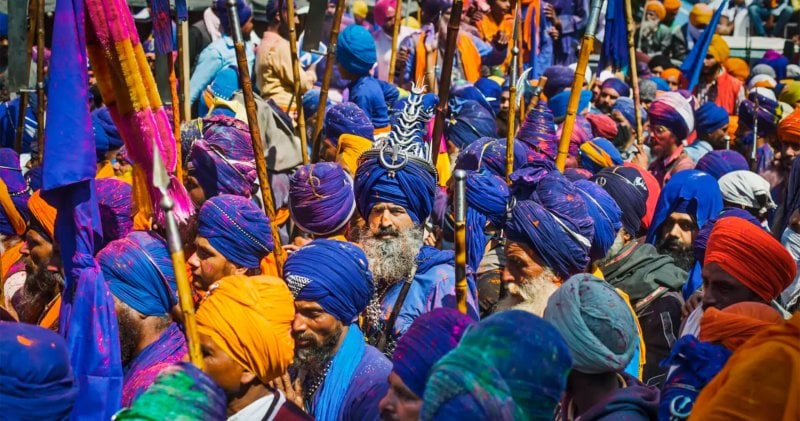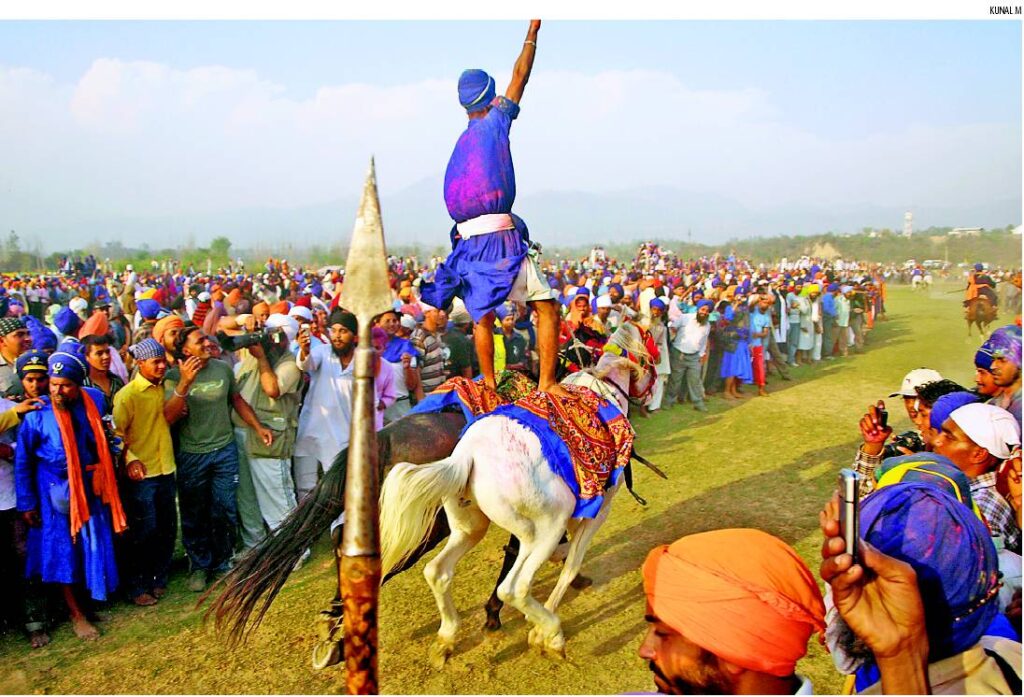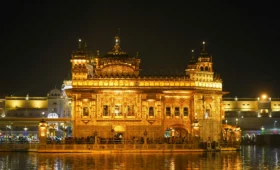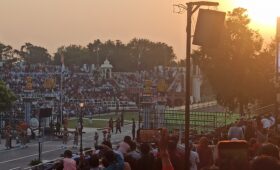Introduction
In the vibrant tapestry of Indian culture and tradition, festivals are woven as colorful threads, each adding its unique hue to the cultural fabric of the nation. Among the myriad festivals that adorn the Indian calendar, Hola Mohalla holds a special place. Celebrated with fervor and zeal, especially in Anandpur Sahib, Punjab, Hola Mohalla is a testament to the valor, spirit, and unity of the Sikh community.

In this extensive exploration, we embark on a journey through the history, present-day celebrations, and the profound significance of Hola Mohalla in Anandpur Sahib. As we delve into the depths of this grand festival, we uncover layers of tradition, spirituality, and community cohesion that define the essence of Hola Mohalla.
History Behind Hola Mohalla
To understand the significance of Hola Mohalla, one must delve into its historical roots. The festival finds its origin in the 18th century under the leadership of the tenth Sikh Guru, Sri Guru Gobind Singh Ji. In response to the growing need for martial prowess and unity among the Sikhs, Guru Gobind Singh Ji established the Khalsa Panth, a community of baptized Sikhs committed to upholding righteousness and protecting the oppressed.
In 1699, Guru Gobind Singh Ji inaugurated the Khalsa Panth during the Vaisakhi festival, marking a pivotal moment in Sikh history. Following the establishment of the Khalsa, Guru Gobind Singh Ji organized a series of military exercises and mock battles to instill valor, discipline, and camaraderie among his followers. These exercises culminated in the celebration of Hola Mohalla, a festival of martial arts, bravery, and spiritual rejuvenation.
The term “Hola Mohalla” derives from the Punjabi words “Hola” meaning “hallowness” or “military parade” and “Mohalla” meaning “an organized procession.” Thus, Hola Mohalla translates to “the grand procession of the military.” Traditionally held a day after the Hindu festival of Holi, Hola Mohalla unfolds as a grand spectacle of martial prowess, spiritual fervor, and communal harmony.

Present-Day Celebrations in Anandpur Sahib
Anandpur Sahib, nestled in the foothills of the Shivalik range in Punjab, serves as the epicenter of Hola Mohalla celebrations. Each year, thousands of devotees, tourists, and martial arts enthusiasts flock to this historic city to partake in the festivities. The entire town comes alive with the sounds of martial music, chanting of hymns, and the rhythmic beat of drums, creating an atmosphere charged with energy and devotion.
The week-long celebrations of Hola Mohalla transform Anandpur Sahib into a bustling hub of activity. The main events include grand processions, martial arts display, poetry recitals, and religious discourses. Nihang Sikhs, adorned in their distinctive attire of blue robes, saffron turbans, and adorned weaponry, take center stage during the festivities, showcasing their martial skills and valor through mock battles known as “Gatka.”
The air resonates with the echoes of “Waheguru Ji Ka Khalsa, Waheguru Ji Ki Fateh” (The Khalsa belongs to God, Victory belongs to God), as devotees immerse themselves in the divine atmosphere of Hola Mohalla. Langars (community kitchens) are organized where volunteers selflessly serve meals to all, irrespective of caste, creed, or status, embodying the Sikh principles of equality and seva (selfless service).

Significance of Hola Mohalla
At its core, Hola Mohalla encapsulates the essence of Sikhism – the harmonious integration of spirituality and martial valor. The festival serves multiple purposes, each enriching the Sikh community in profound ways:
- Celebration of Sikh Identity: Hola Mohalla reaffirms the Sikh identity and commemorates the establishment of the Khalsa Panth by Guru Gobind Singh Ji. It serves as a reminder of the sacrifices made by Sikh Gurus and warriors in upholding righteousness and defending the oppressed.
- Promotion of Martial Traditions: Through martial arts displays and mock battles, Hola Mohalla preserves and promotes traditional Sikh martial arts such as Gatka. It instills a sense of discipline, courage, and unity among the youth, ensuring the continuation of these ancient traditions.
- Community Cohesion and Brotherhood: The festival fosters a sense of unity and brotherhood among Sikhs and people of other communities who participate in the celebrations. Regardless of caste, creed, or social status, all come together as equals to revel in the spirit of Hola Mohalla.
- Spiritual Renewal and Devotion: Hola Mohalla provides an opportunity for spiritual renewal and introspection. Devotees engage in prayers, hymn singing, and religious discourses, deepening their connection with the divine and strengthening their faith.
- Cultural Heritage Preservation: By preserving and celebrating the rich cultural heritage of Sikhism, Hola Mohalla contributes to the cultural tapestry of India. It serves as a platform for the transmission of traditional practices, rituals, and values to future generations.
In essence, Hola Mohalla transcends mere festivities; it is a reaffirmation of Sikh identity, a celebration of resilience, and a testament to the timeless values of courage, compassion, and community. As the sun sets on another Hola Mohalla celebration in Anandpur Sahib, the echoes of martial chants and devotional hymns linger in the air, reminding us of the enduring legacy of this grand festival.

The Global Impact of Hola Mohalla:
While Hola Mohalla has its roots in Punjab, its influence extends far beyond the borders of India. Sikh communities around the world observe the festival with great enthusiasm, organizing local events and gatherings to commemorate the occasion. From Canada to the United Kingdom, from Australia to the United States, Sikhs come together to celebrate their shared heritage and values during Hola Mohalla.
In recent years, efforts have been made to promote Hola Mohalla as a tourist attraction, inviting people from diverse backgrounds to experience the richness of Sikh culture and tradition. Tour packages, cultural exchanges, and educational programs have been developed to introduce visitors to the history, significance, and celebrations of Hola Mohalla in Anandpur Sahib.
Interfaith Harmony:
An integral aspect of Hola Mohalla is its promotion of interfaith harmony and understanding. While rooted in Sikh tradition, the festival has always welcomed individuals from diverse religious backgrounds to join in the celebrations. Hindus, Muslims, Christians, and people of other faiths participate in Hola Mohalla with equal enthusiasm, contributing to the inclusive spirit of the festival.
This interfaith participation is not merely symbolic but reflects the deeply ingrained principles of Sikhism, which emphasize the equality of all human beings and the importance of respecting and honoring diversity. Through shared experiences and mutual respect, Hola Mohalla serves as a powerful catalyst for promoting interfaith dialogue and cooperation.

Celebrating Diversity, Embracing Unity:
At its core, Hola Mohalla embodies the universal values of unity, diversity, and mutual respect. It transcends religious, cultural, and geographical boundaries, uniting people from all walks of life in a spirit of camaraderie and celebration. Whether in Anandpur Sahib or in cities and towns around the world, Hola Mohalla serves as a shining example of the power of community, solidarity, and shared humanity.
As we celebrate Hola Mohalla, let us reaffirm our commitment to building a world where diversity is celebrated, differences are respected, and all individuals can live in harmony and peace. May the spirit of Hola Mohalla inspire us to embrace one another with open hearts and minds, recognizing the beauty of our shared humanity amidst the rich tapestry of our cultural and religious traditions.

Conclusion
In the sacred precincts of Anandpur Sahib, amidst the majestic backdrop of the Shivalik hills, Hola Mohalla unfolds as a grand saga of valor, devotion, and unity. Steeped in history and tradition, this festival transcends temporal boundaries, connecting the present with the past and inspiring future generations to uphold the noble ideals of Sikhism.
As we bid adieu to yet another Hola Mohalla celebration, let us carry forth the spirit of courage, compassion, and community that defines this auspicious occasion. May the echoes of “Waheguru Ji Ka Khalsa, Waheguru Ji Ki Fateh” reverberate in our hearts, guiding us on the path of righteousness and selfless service.



